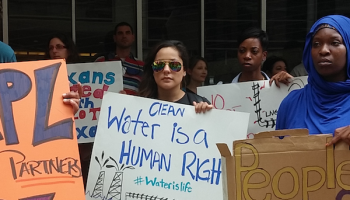Roadmap for Comprehensive Chemicals Policy
HealthyStuff.org urges manufacturers to adopt a comprehensive chemicals policy for their company. The Lowell Center for Sustainable Production at the University of Massachusetts Lowell launched a new State Chemicals Policy Database for legislators, policymakers, researchers and advocates that houses more than 700 state and local legislative and executive branch policies from all 50 states from 1990 to the present.
Elements of a Comprehensive Chemicals Policy
- Know what is contained in your products:
- Know the chemical components of your products.
- Know the process chemicals required to make your products.
- Know the life-cycle impacts of your products including the chemicals released during product use, and their degradation and combustion byproducts.
- Signal vendors that complete chemical ingredient information will be required over time.
- Prescreen all chemicals before use for safety:
- Establish a baseline set of criteria that any chemical must meet in order to be used in company products. The criteria must be protective of children's health.
- All new chemicals the company contemplates using should receive the highest level screening, to prevent the integration of a new problem chemical into the company's manufacturing system.
- Ensure that all chemical components in existing products are tested to assess hazards:
- Comprehensively assess all chemicals/materials in products for health/safety and environmental concerns throughout the life cycle of that chemical/material. Use screening tools where direct testing data is not available (the EPA has a series of on-line tools) to determine the hazard profile of all chemical components
- Initially screen all chemical components and process chemicals against existing lists of chemicals of concern
- Work toward comprehensive testing (or urge upstream suppliers to provide comprehensive testing data) for key health and environmental endpoints of concern for children's health
- Evaluate all chemicals based on their inherent hazards, not on a risk characterization. Prioritization may incorporate risk characterization.
- Over time, only use chemicals that have been fully tested for their ability to harm health or the environment, and found to be less hazardous. Phase out chemicals that have not been tested.
- Signal vendors that complete chemical testing will be required for chemical components of products over time.
- Eliminate the worst chemicals and commit to continuous improvement:
- Commit to using only inherently low hazard chemicals.
- Set goals for benchmarking progress to safer chemicals and prioritize high hazard chemicals for substitution with safer alternatives.
- Commit to eliminating lead, mercury, and cadmium and other persistent, bioaccumulative toxic chemicals immediately as a first step, and phase out the use of PVC with dangerous additives
- Prohibit chemicals with a high hazard profile. These may be chemicals that persist and bioaccumulate; chemicals that are known carcinogens, mutagens and reproductive toxicants; known neurotoxicants; and chemicals that are ecologically harmful, etc. This list should go beyond regulatory requirements. The list should be developed by first evaluating the inherent hazards of a chemical, then prioritizing based on a life cycle assessment of the threats posed by the chemical/material. The list of attributes that are prohibited should grow over time, in order to achieve a chemical profile for the company that includes primarily low hazard chemicals.
- Commit to continuous improvement in the toxicity profile of all chemicals used. Establish goals to reduce the overall toxicity profile for the company. Those goals should be reviewed regularly and should continually improve the chemical profile of the company. Develop metrics to capture cost savings and other benefits of the program. Align employee incentives with this goal.
- Disclose ingredients. Label and bar cobarcodeherwise provide health/safety/environmental attributes of products for consumers/user in a way that is easy for the consumer to access.
- Publicly support government chemical reform measures. Companies can provide a powerful voice for change at the state and federal level. Individual chemicals policies by companies are an inefficient way to provide comprehensive testing information to all downstream users. Companies should support the reform of chemicals management laws so that adequate information on chemical impacts is provided to downstream users to choose the safest and most effective chemicals. Companies should also support the development of safer alternatives, and the creation of incentives to accelerate the development of safer materials.
- Be socially responsible. Contract from and operate facilities that meet basic human rights for workers and provide safe and healthy workplaces.
- Publicly disclose progress. Disclose the policy and progress towards achieving it on your company's website, in your annual CSR/sustainability reporting, and in the media.

